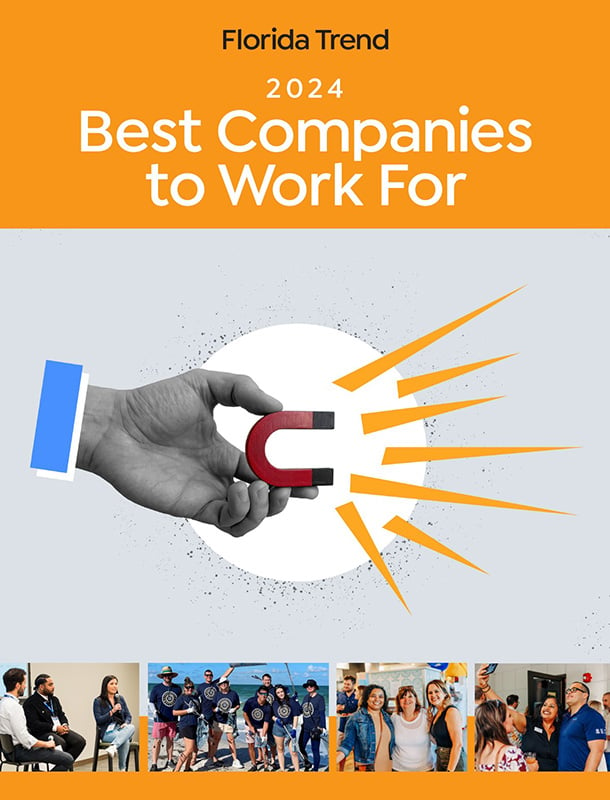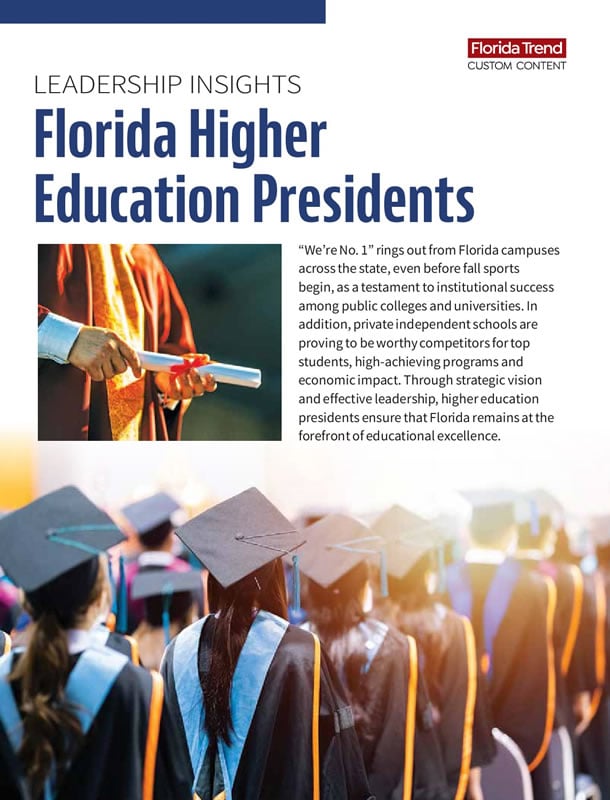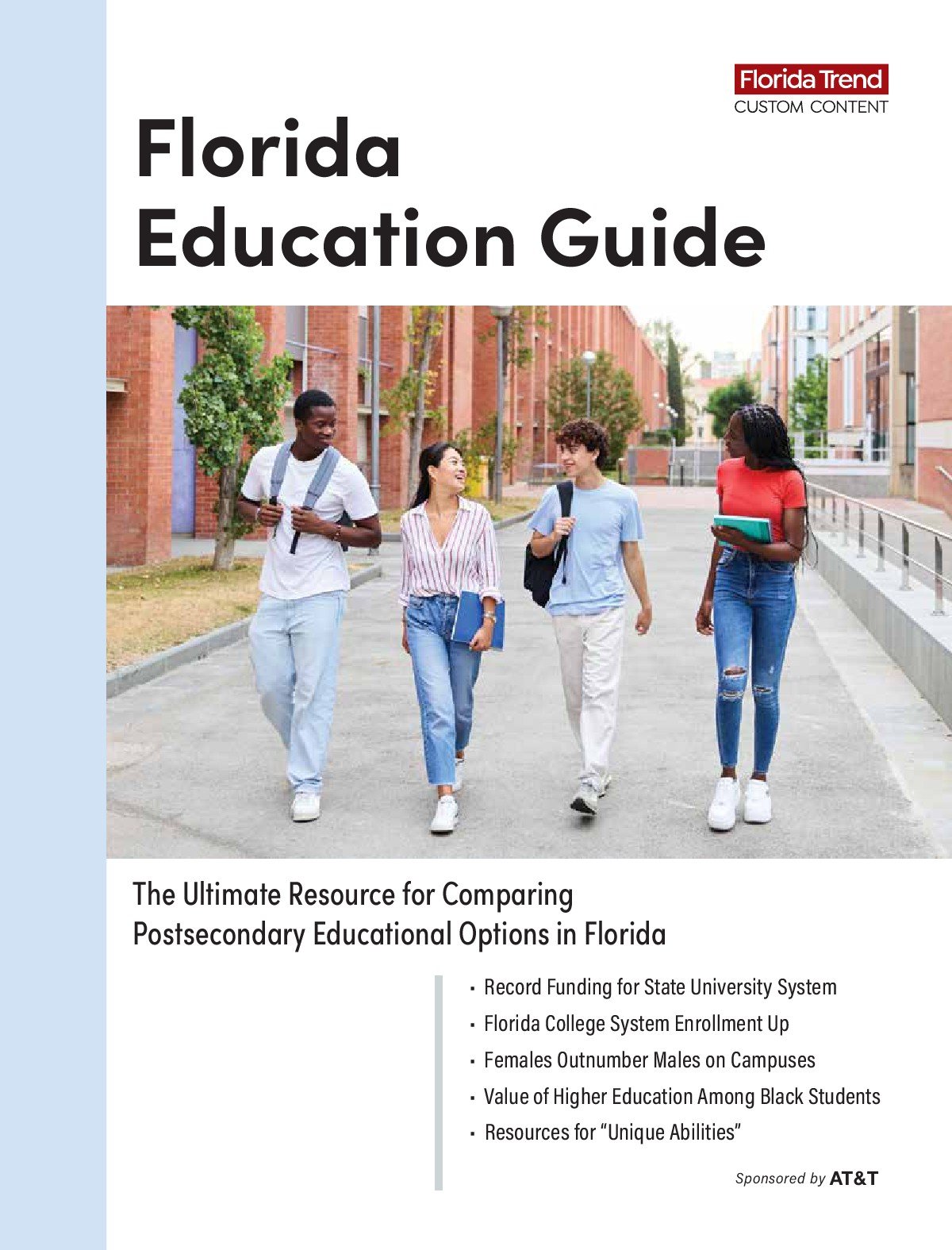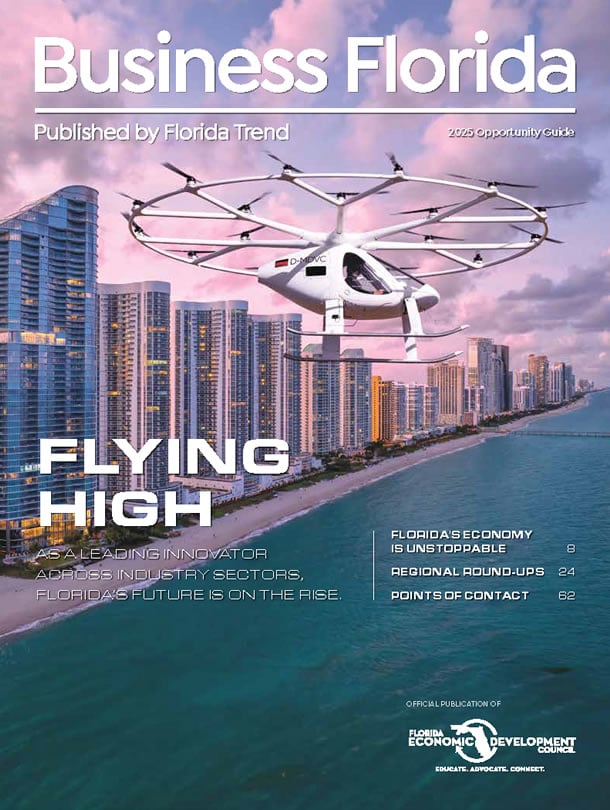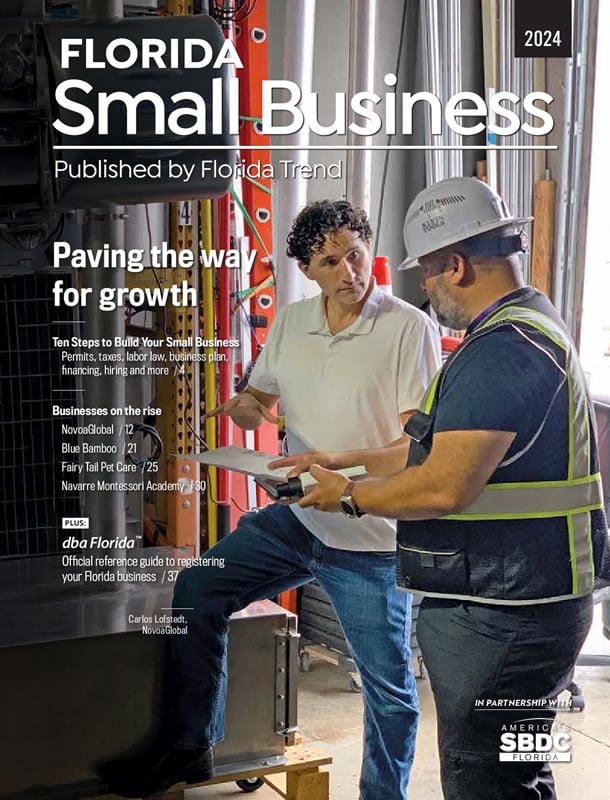March 25, 2025 | Michael Fechter
With an eye on future revenue projections, budget restraint is a priority when the legislative session begins March 4.
Florida House Speaker Daniel Perez cites the growth of Florida’s budget with a sense of bewilderment. It was $84 billion when he was elected in 2017 to represent Miami’s Westchester community. Last year it was $116.5 billion.
Florida’s roaring economy combined with federal stimulus funds made such spending possible, but as a result, legislators “have lost any sense of discipline,” he told House members in November after being sworn in as speaker. It is time “to build a state budget that values value.”
Florida’s population and economy should continue to grow, but that growth is expected to slow significantly in the next four years. Florida’s GDP expanded at a healthy 4.5% in 2023-24, but by 2026 it is projected to be only about 2%.
In an interview, Perez says that fiscal restraint is a responsibility, and “anything that has to do with the budget is on the table.”
"I wanted the priorities of the House to be written by the members as opposed to being written by me simply because I sit in a corner office. I wanted to make sure that the members are coming up with what they believe are the most important items that need to be solved for within the House.” – House Speaker Daniel Perez
“I don’t want to leave the Legislature in a difficult position when I’m gone in 2026. I don’t want them to start to see a deficit looming (on) the horizon when I could have fixed it on the front end,” he says.
“ Being prudent, being most well informed, being collaborative is all part of governing — the approach I want to take with this. … My goal is every day to learn as much as I can about all of
the things that we touch.” – Senate President Ben Albritton
He’s not exaggerating. According to an October budget outlook published by Florida TaxWatch, a nonprofit focused on government efficiency, the state should see a $2.1-billion budget surplus in the next fiscal year. But “if the Legislature stays on the current spending course, the state is headed for a deficit of $2.8 billion in FY2026-27. The deficit would then balloon to $6.9 billion the following year.”
Perez’s reproach was needed, says TaxWatch President and CEO Dominic Calabro. “I really appreciate the Speaker’s approach to that to say, ‘Look, you’re not merely appropriators. This is a budget, and you’ve got to treat it really as a fiduciary rather than spend the money because we can.’”
One easy way to rein in spending is to curtail the volume of member projects that fund everything from arts to infrastructure but often don’t go through the same review process and tend to be contained within an individual legislator’s district.
The current budget is the third in a row that contains at least $2.8 billion in member projects, TaxWatch says. That includes 281 water projects costing $411 million. In an October 2023 report, it proposed developing a system to prioritize water projects several years down the road, similar to the state Department of Transportation’s five-year work plans.
Senate President Ben Albritton says that could be in the works, and he is consulting with the Florida Department of Agriculture and Consumer Services’ Office of Agricultural Water Policy.
“The historic record shows that the DOT five-year work plan produces excellent results in that it is predictable, it’s measured,” Albritton says. “There’s a lot of thought that goes into it, and it helps everyone involved in the system of transportation to be able to see around the corner a lot better than just an approach of a year-to-year-to-year basis.”
The state needs to spend about $1.7 billion on critical water projects in the next 15 years to ensure “that future water supplies are available to meet the increase in water demands,” the state’s Office of Economic & Demographic Research reported last year — so spending will continue. The question is how it will be allotted and managed.
Water supply authorities and management districts might play bigger roles in identifying projects that can have a more regional affect than a member project, says Kim Dinkins, policy and planning director for the nonprofit group 1000 Friends of Florida, which promotes “smart growth.”
“We know that the need for water quality and water supply projects exceeds the amount of funding available,” Dinkins says, “so we can’t afford to fund projects that don’t have a big public benefit.”
It takes time, she cautions, but the Senate President’s support is significant. The idea has been around for well over a decade but hasn’t led to change.
Albritton says he is committed to changing that, telling reporters in December that “water quality and quantity is going to be a big deal” during session. In a November speech to the Senate, he called for “a renewed data-driven focus on water,” noting that can range from stormwater to septic tanks “and any other source harmful to nature.”
Affordability issues
Lawmakers say they want to address property insurance rates, too, but specific plans are lacking. “In a state battered by hurricanes, insurance will be a challenge,” Perez told House members in November.
House and Senate leaders say the insurance market was stabilizing, with more insurers coming into the state and rates holding steady or even decreasing slightly, before hurricanes Helene and Milton battered Florida, causing an estimated $23 billion in damage. It’s too soon to know how the billions of dollars in damage will affect the insurance market, but the South Florida Sun Sentinel recently reported that insurance premiums in Florida increased by 3.1% in mid-2024.
Lawmakers have already done what insurers said was needed, primarily by making it more difficult for customers to sue, Albritton told the Senate. It’s the industry’s turn to deliver. “I’m not going to sit idly by if legitimate claims get denied while rates continue to rise. Period.” But he hasn’t said what he’d do if the status quo holds.
The status quo is trending in the right direction, says Logan McFaddin, vice president of state operations for the American Property Casualty Insurance Association. She cites data from the state Office of Insurance Regulation showing nine new property and casualty insurers are writing policies in Florida, that the state-run Citizens Property Insurance Corp. has dropped below 1 million policies and that 25 carriers filed for rate reductions while another 49 are not changing rates.
Protecting reforms passed in 2022 and 2023 is the top priority, McFaddin says. And insurers would like to see legislation pass that would require that civil courts and juries be informed when litigation is financed by a third party. Plaintiffs “often see little — if any — of the award or settlement” when they prevail, she says, with the bulk of any damages going to hedge funds or foreign actors “who have no relationship to the claimant or issue being litigated.”
While the Legislature’s priorities are sketched out in broad strokes, few specific plans were unveiled by the time committees started meeting in mid-January.
Even though Republicans continue to enjoy super-majorities in both the House and Senate, the somewhat open template could foster working across party lines, says House Minority Leader Fentrice Driskell (D-Tampa) “I’m hoping that this means there’s more of a blank slate and that some opportunities for bipartisan cooperation will emerge.”
That includes finding ways to address the state’s affordable housing challenges. “Because the cost of housing is such a big problem in Florida, everybody has to be willing to come to the table and discuss potential options even if they may not be the most desirable options,” Driskell says. “You’ve got to put our pride aside and figure out how can we accomplish this goal of making sure that people have a place to live that they can afford.”
Nearly 3 million of the state’s 8.6 million households spent 30% to 50% of their gross income on housing in 2022, the University of Florida’s Shimberg Center for Housing Studies estimated.
While Florida continues to grow, largely by people choosing to move here, there are a couple of ominous data points for the state’s economy in the Florida Chamber of Commerce’s 2023 migration report. Net migration for the year was 126,000 more residents, which is half of 2022’s tally. Florida ranked second to California for the number of people moving out. And in the 20-29 age bracket, more people left the state than moved in.
“The No. 1 reason is they can’t afford homes,” says Florida Chamber President and CEO Mark Wilson.
The 30-39 bracket saw a minimal gain. Those generations constitute the future workforce needed for a growing state.
Perez has said he is “very concerned” and wants to see what can be done to make “it more affordable to keep our talent here.” In addition to passing the 2023 Live Local Act’s package of tax and permitting incentives, the state invested $508 million in affordable housing trust funds last year, which pay for programs offering incentives and low- or no-interest loans to help fund construction of affordable housing and help first-time homebuyers with downpayments.
Florida will never be able to meet the entire need for affordable housing units, says Sandra Veszi Einhorn, the new board chair for the Florida Housing Finance Corp., which manages the state allotments. But there are more “tools in the solution box” from legislation like Live Local that help chip away at the problem.
“Every household that becomes housing stable is a household that then becomes a better consumer of the economy, less reliant on the social service safety net,” she says.
Rural focus
Albritton speaks at length about his desire to see a “rural renaissance” take root during his Senate presidency. That includes expanding access to health care, investing in infrastructure. “Rural Florida is full of unrealized potential, un-realized opportunity,” he told reporters in December.
Albritton and Perez seem to be taking a cautious, “do-no-harm” approach and favor business-friendly policies to continue growing Florida’s economy.
But too many of its residents with serious health challenges are forced to choose between missing work to drive great distances for treatment or putting off needed care. Part of the answer could involve sending more mobile screening units into the heartland and beefing up telehealth access.
“There’s a lot to review and a lot to really understand where rural Florida stands in this space,” Albritton says.
There also could be manufacturing opportunities in rural counties that are relatively close to cities if the state chooses to invest, the Chamber’s Wilson says. Land is cheaper, and state colleges are helping train the workforce needed.
“Thirty million (dollars) of infrastructure in Putnam County changes the county,” Wilson says. “Thirty million of infrastructure on a street corner in Miami might alleviate some traffic, but everybody in Miami-Dade County doesn’t notice it.”
Hurricane resilience investments could help rural parts of the Florida Panhandle, which have been battered repeatedly by hurricanes in recent years, to recover, says Ryan Matthews, a former Department of Environmental Protection Secretary under Gov. Rick Scott who now is a shareholder in GrayRobinson’s government affairs and lobbying section. Those areas don’t have a property tax base sufficient to fund the recovery. But the state could invest in innovative hurricane mitigation efforts like seagrass beds and wave attenuation devices — often pyramid-shaped structures that can reduce the force and energy in storm surges.
“A peninsula state like Florida would be wise to be looking at a lot of those technologies to try to get out ahead of some of the damage that is caused,” Matthews says.
There may be more unknowns in the 2025 session than in recent years. But Albritton and Perez each seem to appreciate that a cautious approach helps the state avoid unintended consequences.
“When you have an economy that is moving in a great direction as ours is, ‘do no harm’ is important,” Albritton says.
“We’re going to continue to push some of the same policies that have made this a business-friendly state in order to continue to grow the economy,” Perez says. “I wouldn’t expect any changes that are going to hurt the business community and send our state in a different direction.”
The New Leaders
➤ House Speaker Daniel Perez, 37
Education: JD, Loyola University New Orleans College of Law (2012); BA, Florida State University (2009)
Family: Married, two children
Hometown: Miami
Career: Attorney
Legislative career: Elected to the Florida House in a 2017 special election
➤ Senate President Ben Albritton, 56
Education: Bachelor’s degree, Florida Southern College (1990)
Family: Married, three children, one grandchild
Hometown: Wauchula
Career: Fourth-generation farmer
Legislative career: Elected to Florida House in 2010; Elected to Florida Senate in 2018
Fighting Hunger
“Food insecurity in Florida is very real,” says Florida Senate President Ben Albritton, a fourth-generation citrus farmer. “One of the things that keeps me up at night is the idea that there are children that go to bed hungry in Florida.” He is working with Agriculture Commissioner Wilton Simpson, a former Senate President and egg farmer, to bridge the gap between farm families and food-insecure families.
In August, Simpson announced a partnership between the Florida Department of Agriculture and Consumer Services and Feeding Florida food banks to get more protein-rich meat and dairy products to the state’s food banks. Albritton helped get $6.5 million into the state budget for the program.
Albritton believes more can be done, especially when it comes to excess product that often gets thrown out today. Homestead-based Farm Share, the state’s largest food bank, has been “recovering surplus crops from Florida farmers” for more than three decades and is likely to play a significant role in any additional state efforts to combat hunger.
Albritton’s support is well-established, says Farm Share CEO Stephen Shelley. It received “record funding” when Albritton chaired the Senate Appropriations Committee’s agricultural arm. The money helped “support millions of Floridians in their time of need, including during disasters such as pandemics and hurricanes.”
Albritton says he is motivated both by his faith — which “tells me that every human life matters” — and a public policy concern about the adverse effects of growing up undernourished. He also believes it can be a unifying issue. “I will tell you this, of all the things that I have worked on — and there’s actually a pretty long list over 14 years — but of all the things that I’ve worked on in the Florida Legislature, this is the most exciting and the most rewarding.”



